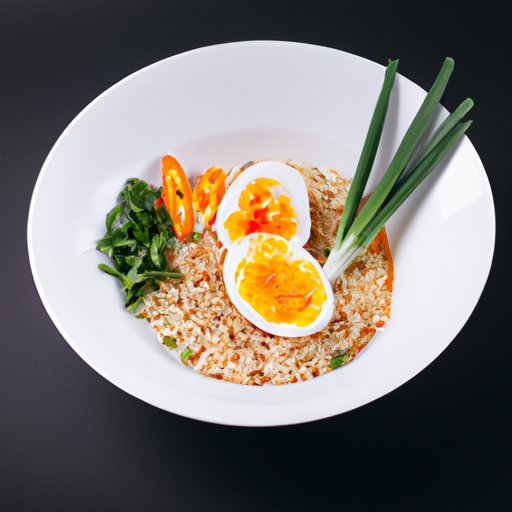Introduction
Do you find yourself enjoying ramen at your local noodle shops, but always feeling like there is room for improvement? Or, are you simply a lover of ramen but want to take your grocery store pack to the next level? Either way, you’re in luck. In this article, we’ll share some techniques and tips on how to make your ramen better. Whether you’re a ramen novice or an experienced noodle enthusiast, you’ll find some valuable insights here.
Upgrade Your Broth
The broth is the heart and soul of ramen, and upgrading it can make all the difference in your overall dish. A few tips to keep in mind as you work on your broth also include the use of high-quality broth, aromatics, and experimenting with seasonings.
One key way to upgrade your broth is to start with high-quality broth as a base. Homemade broth may seem intimidating, but it does not have to be time-consuming or complicated to make. A simple broth can be created by simmering chicken bones, pork bones, or a combination of both with some veggies like onions, garlic, and ginger. Store-bought broth serves as an excellent substitute in a pinch.
Another technique to enhance your broth is to add aromatics. Aromatic ingredients such as onions, leeks, garlic, and ginger can add a depth of flavor to your ramen broth. Experiment with different combinations to find your perfect flavor.
Lastly, feel free to experiment with various seasonings, such as miso, soy sauce, and vinegar. With these different seasonings, you can switch up the taste and overall experience of your broth-based ramen dish.
For example, try making shoyu ramen with savory soy sauce, or spicy miso with a kick of heat.
Add Protein
While ramen is traditionally served with pork belly or char siu, it is possible to get creative with your protein options. For example, one could use seafood, chicken, or tofu to add texture and protein to their ramen dish. The cooking and seasoning of your protein can also make a big difference.
If you are using meat in your ramen, make sure to cook it with care. Pork belly, for example, does not need many seasonings beyond a sprinkle of salt and pepper. You can also braise the meat in broth and use this as a topping, or grill it for a charred flavor.
Seafood is another excellent protein option in ramen. Shrimp, clams, and crab can provide a delicious seafood flavor to your ramen dish. As with meat, you’ll want to cook them carefully to ensure that they retain their juicy texture.
If you prefer a meat-free option, tofu can provide the necessary protein. Firm tofu works best in ramen dishes with a crispy exterior and soft inside. You can season with soy sauce, ginger, and garlic, or fry it until crispy before adding it to your ramen bowl.
Spice it Up
Ramen is known for its mild, comforting flavor, but sometimes, you crave a bit of a kick. Adding spices to your ramen can not only provide heat, but it can also add complexity and depth to the overall dish.
Try adding chili oil or hot sauce to your ramen for a touch of heat that complements the broth. Jalapeños, Thai chilies, and even sliced garlic can also be added to spice up your ramen. You can even use other spices like cumin or caraway to experiment with different flavor profiles.
Roast Your Vegetables
Roasting vegetables is a delicious way to add extra depth and flavor to your ramen broth. You can roast any veggies that complement your dish; some popular options include carrots, mushrooms, and onions. Here are some tips for roasting veggies for your ramen bowl:
Generously coat your vegetables with oil and sprinkle salt and pepper.
Roast vegetables at a high temperature (around 400°F) for 25-30 minutes until they are tender.
Finish with a touch of sesame oil or fish sauce.
This simple technique will help to elevate the flavors in your ramen.
Swap Out The Noodles
Ramen noodles are integral to the dish, but there are so many noodles that can be used in ramen. Alternative noodles can help to make your dish healthier or provide an opportunity to experiment with different textures and flavors.
Udon noodles, for example, are thicker than ramen noodles, providing a chewier texture. Soba noodles, on the other hand, are thinner and made from buckwheat flour, making them more nutritious and gluten-free. Zucchini noodles can also be used as a healthy, low-carb option.
Add Some Freshness
Last but not least, to make your ramen bowl pop, add some fresh ingredients. Fresh ingredients add a crisp texture to your soup, which can help to balance out the rich, salty flavors of the broth.
Some toppings that can provide freshness include thinly-sliced scallions, bean sprouts, fresh cilantro, or shredded vegetables. You can also add some sauces like sriracha, ponzu, or chili oil, to add a tangy twist to the ingredients.
Conclusion
Ramen is a delicious, comforting dish. With these tips and techniques, you can take your ramen bowl from average to amazing. Start upgrading your broth, adding protein, spicing it up, roasting your vegetables, swapping out the noodles, and adding some freshness. By following these guidelines, you will be making the perfect bowl of ramen in no time.
Remember to experiment, adding your flavor and finding what works for you, so you can enjoy the bowl of ramen that is tailor-made to your tastes.
